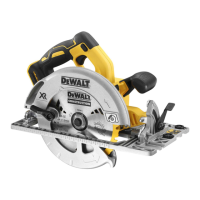16
ENGLISH
recommended speed (rpm) on the saw blade meets or
exceeds the speed (rpm) of thesaw.
6. Follow steps 1 through 5 under To Install the Blade, making
sure that the blade will rotate in the properdirection.
Lower Blade Guard
WARNING: The lower blade guard is a safety feature
that reduces the risk of serious personal injury. Never
use the saw if the lower guard is missing, damaged,
misassembled or not working properly. Do not rely
on the lower blade guard to protect you under all
circumstances. Your safety depends on following
all warnings and precautions as well as proper
operation of the saw. Check the lower blade guard
for proper closing before each use. If the lower blade
guard is missing or not working properly, have the
saw serviced before using. To assure product safety
and reliability, repair, maintenance and adjustment
should be performed by an authorized service center
or other qualified service organization, always using
identical replacementparts.
Checking the Lower Guard (Fig.A)
1. Turn tool off and disconnect from powersupply.
2. Rotate the lower guard lever (Fig.A,
5
) from the fully closed
position to the fully openposition.
3. Release the lever and observe the guard
7
return to the
fully closedposition.
The tool should be serviced by a qualified service center if it:
• fails to return to the fully closed position,
• moves intermittently or slowly, or
• contacts the blade or any part of the tool in all angles and
depth ofcut.
Blades
WARNING: To minimise the risk of eye injury, always
use eye protection. Carbide is a hard but brittle material.
Foreign objects in the workpiece such as wire or nails
can cause tips to crack or break. Only operate saw when
proper saw blade guard is in place. Mount blade securely
in proper rotation before using, and always use a clean,
sharpblade.
WARNING: Do not cut metal, plastic, concrete, masonry
or fiber cement materials with thissaw.
184 mm Diameter
Application Teeth
Rip 24
General Purpose 36
Finish 60
If you need assistance regarding blades, please contact your
local
dealer.
Kickback
Kickback is a sudden reaction to a pinched, bound or misaligned
saw blade, causing an uncontrolled saw to lift up and out of the
workpiece toward the operator. When the blade is pinched or
bound tightly by the kerf closing down, the blade stalls and the
motor reaction drives the unit rapidly back toward the operator.
If the blade becomes twisted or misaligned in the cut, the teeth
at the back edge of the blade can dig into the top surface of the
wood causing the blade to climb out of the kerf and jump back
toward theoperator.
Kickback is more likely to occur when any of the following
conditionsexists.
1. IMPROPER WORKPIECE SUPPORT
a. Sagging or improper lifting of the cut off piece can cause
pinching of the blade and lead tokickback.
b. Cutting through material supported at the outer ends
only can cause kickback. As the material weakens it sags,
closing down the kerf and pinching the blade (Fig.L).
c. Cutting off a cantilevered or overhanging piece of
material from the bottom up in a vertical direction
can cause kickback. The falling cut off piece can pinch
theblade.
d. Cutting off long narrow strips (as in ripping) can cause
kickback. The cut off strip can sag or twist closing the kerf
and pinching theblade.
e. Snagging the lower guard on a surface below the
material being cut momentarily reduces operator control.
The saw can lift partially out of the cut increasing the
chance of bladetwist.
2. IMPROPER DEPTH OF CUT SETTING ON SAW
a. To make the most efficient cut, the blade should protrude
only far enough to expose one-half of a tooth as shown
in FigureF. This allows the base plate to support the blade
and minimises twisting and pinching in the material. See
the section titled Depth of CutAdjustment.
3. BLADE TWISTING MISALIGNMENT IN CUT
a. Pushing harder to cut through a knot, a nail or a hard
grain area can cause the blade totwist.
b. Trying to turn the saw in the cut (trying to get back on
the marked line) can cause bladetwist.
c. Overreaching or operating the saw with poor body
control (out of balance), can result in twisting theblade.
d. Changing hand grip or body position while cutting can
result in bladetwist.
e. Backing up the saw to clear blade can lead totwist.
4. MATERIALS THAT REQUIRE EXTRA ATTENTION
a. Wet timber
b. Green timber (material freshly cut or not kiln dried)
c. Pressure treated timber (material treated with
preservatives or anti-rot chemicals)
5. USE OF DULL OR DIRTY BLADES
a. Dull blades cause increased loading of the saw. To
compensate, an operator will usually push harder which
further loads the unit and promotes twisting of the blade
in the kerf. Worn blades may also have insufficient body
clearance which increases the chance of binding and
increasedloading.

